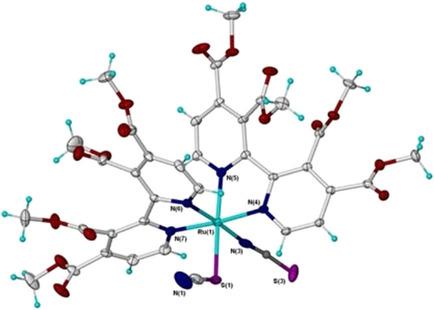当前位置:
X-MOL 学术
›
ChemPlusChem
›
论文详情
Our official English website, www.x-mol.net, welcomes your
feedback! (Note: you will need to create a separate account there.)
Tetracarboxylate Bis-Bipyridine Ruthenium Dyes: Synthesis, Structural and Electronic Characterisation.
ChemPlusChem ( IF 3.0 ) Pub Date : 2018-06-04 , DOI: 10.1002/cplu.201800116 Clint P Woodward 1 , Thomas Rüther 1 , Campbell J Coghlan 1 , Timothy W Jones 2 , Yanek Hebting 3 , Richard L Cordiner 3 , Ryan E Dawson 3 , Diane E J E Robinson 3 , Craig M Forsyth 4 , Gregory J Wilson 2
ChemPlusChem ( IF 3.0 ) Pub Date : 2018-06-04 , DOI: 10.1002/cplu.201800116 Clint P Woodward 1 , Thomas Rüther 1 , Campbell J Coghlan 1 , Timothy W Jones 2 , Yanek Hebting 3 , Richard L Cordiner 3 , Ryan E Dawson 3 , Diane E J E Robinson 3 , Craig M Forsyth 4 , Gregory J Wilson 2
Affiliation

|
The preparation of ruthenium complexes with novel 2,2'-bipyridine (bpy) ligands bearing four carboxylic acid groups was investigated with a view to creating dyes containing more than two potential anchoring groups per bpy unit for attachment to a titania surface. Synthetic challenges are encountered upon using the 2,2'-bipyridine-3,3',4,4'-tetracarboxylic acid ligand because it readily decarboxylates. The use of the methyl esterified derivative (3) proved to be more successful for complex preparation, with a robust preparation of the [Ru(3)2 Cl2 ] complex identified with diglyme as the solvent. This complex was further converted into the thiocyanato complex, [Ru(3)2 (NCS)2 ], which could not be completely de-esterified. X-ray analysis of crystals obtained from a mixture of isomers for this complex provided data for the S,S- and N,S-coordinated isomers; both showed a twisted arrangement of the pyridine rings in the 2,2'-bipyridine-3,3',4,4'-tetracarboxylic acid ligand, owing to steric hinderance. Conversely, the isosteric 2,2'-bipyridine-4,4',5,5'-tetracarboxylic acid ligand was easily converted into the desired [Ru(2)2 (NCS)2 ] complex through a standard one-pot procedure in N,N-dimethylformamide solvent. All of the complexes presented herein exhibit a significant redshift for the metal to ligand charge-transfer bands, relative to the benchmark ruthenium dye N719 and derivatives thereof. All complexes exhibit a quasi-reversible process for the ruthenium(II/III) couple at approximately 0.4 V versus the ferrocene couple, comparable to analogous ruthenium dyes.
中文翻译:

四羧酸双-联吡啶钌染料:合成,结构和电子表征。
研究了具有带有四个羧酸基团的新型2,2'-联吡啶(bpy)配体的钌配合物的制备,目的是创建每bpy单元包含两个以上潜在锚固基团的染料,用于连接二氧化钛表面。使用2,2'-联吡啶-3,3',4,4'-四羧酸配体时会遇到合成难题,因为它容易脱羧。甲基酯化衍生物(3)的使用被证明对于复合物的制备是更成功的,其中以二甘醇二甲醚为溶剂的[Ru(3)2 Cl2]复合物的制备非常可靠。该配合物进一步转化为硫氰酸根配合物[Ru(3)2(NCS)2],该配合物无法完全脱酯。从该异构体的异构体混合物中获得的晶体的X射线分析提供了S,S和N的数据,S-配位异构体;由于位阻,两者均显示出2,2'-联吡啶-3,3',4,4'-四羧酸配体中吡啶环的扭曲排列。相反,通过标准的一锅法,等规2,2'-联吡啶-4,4',5,5'-四羧酸配体很容易转化为所需的[Ru(2)2(NCS)2]复合物N,N-二甲基甲酰胺溶剂。相对于基准钌染料N719及其衍生物,本文呈现的所有配合物对于金属至配体的电荷转移带均表现出显着的红移。与二茂铁对相比,所有络合物在约0.4 V的钌(II / III)对下均表现出准可逆过程,与类似的钌染料相当。-β-吡啶-3,3',4,4'-四羧酸配体,由于空间位阻。相反,通过标准的一锅法,等规2,2'-联吡啶-4,4',5,5'-四羧酸配体很容易转化为所需的[Ru(2)2(NCS)2]复合物N,N-二甲基甲酰胺溶剂。相对于基准钌染料N719及其衍生物,本文呈现的所有配合物对于金属至配体的电荷转移带均表现出显着的红移。与二茂铁对相比,所有络合物在约0.4 V的钌(II / III)对下均表现出准可逆过程,与类似的钌染料相当。-β-吡啶-3,3',4,4'-四羧酸配体,由于空间位阻。相反,通过标准的一锅法,等规2,2'-联吡啶-4,4',5,5'-四羧酸配体很容易转化为所需的[Ru(2)2(NCS)2]复合物N,N-二甲基甲酰胺溶剂。相对于基准钌染料N719及其衍生物,本文呈现的所有配合物对于金属至配体的电荷转移带均表现出显着的红移。与二茂铁对相比,所有络合物在约0.4 V的钌(II / III)对下均表现出准可逆过程,与类似的钌染料相当。通过标准的一锅法,在N,N-二甲基甲酰胺溶剂中,可以轻松地将-四羧酸配体转化为所需的[Ru(2)2(NCS)2]络合物。相对于基准钌染料N719及其衍生物,本文呈现的所有配合物对于金属至配体的电荷转移带均表现出显着的红移。与二茂铁对相比,所有络合物在约0.4 V的钌(II / III)对下均表现出准可逆过程,与类似的钌染料相当。通过标准的一锅法,在N,N-二甲基甲酰胺溶剂中,可以轻松地将-四羧酸配体转化为所需的[Ru(2)2(NCS)2]络合物。相对于基准钌染料N719及其衍生物,本文呈现的所有配合物对于金属至配体的电荷转移带均表现出显着的红移。与二茂铁对相比,所有络合物在约0.4 V的钌(II / III)对下均表现出准可逆过程,与类似的钌染料相当。
更新日期:2018-06-04
中文翻译:

四羧酸双-联吡啶钌染料:合成,结构和电子表征。
研究了具有带有四个羧酸基团的新型2,2'-联吡啶(bpy)配体的钌配合物的制备,目的是创建每bpy单元包含两个以上潜在锚固基团的染料,用于连接二氧化钛表面。使用2,2'-联吡啶-3,3',4,4'-四羧酸配体时会遇到合成难题,因为它容易脱羧。甲基酯化衍生物(3)的使用被证明对于复合物的制备是更成功的,其中以二甘醇二甲醚为溶剂的[Ru(3)2 Cl2]复合物的制备非常可靠。该配合物进一步转化为硫氰酸根配合物[Ru(3)2(NCS)2],该配合物无法完全脱酯。从该异构体的异构体混合物中获得的晶体的X射线分析提供了S,S和N的数据,S-配位异构体;由于位阻,两者均显示出2,2'-联吡啶-3,3',4,4'-四羧酸配体中吡啶环的扭曲排列。相反,通过标准的一锅法,等规2,2'-联吡啶-4,4',5,5'-四羧酸配体很容易转化为所需的[Ru(2)2(NCS)2]复合物N,N-二甲基甲酰胺溶剂。相对于基准钌染料N719及其衍生物,本文呈现的所有配合物对于金属至配体的电荷转移带均表现出显着的红移。与二茂铁对相比,所有络合物在约0.4 V的钌(II / III)对下均表现出准可逆过程,与类似的钌染料相当。-β-吡啶-3,3',4,4'-四羧酸配体,由于空间位阻。相反,通过标准的一锅法,等规2,2'-联吡啶-4,4',5,5'-四羧酸配体很容易转化为所需的[Ru(2)2(NCS)2]复合物N,N-二甲基甲酰胺溶剂。相对于基准钌染料N719及其衍生物,本文呈现的所有配合物对于金属至配体的电荷转移带均表现出显着的红移。与二茂铁对相比,所有络合物在约0.4 V的钌(II / III)对下均表现出准可逆过程,与类似的钌染料相当。-β-吡啶-3,3',4,4'-四羧酸配体,由于空间位阻。相反,通过标准的一锅法,等规2,2'-联吡啶-4,4',5,5'-四羧酸配体很容易转化为所需的[Ru(2)2(NCS)2]复合物N,N-二甲基甲酰胺溶剂。相对于基准钌染料N719及其衍生物,本文呈现的所有配合物对于金属至配体的电荷转移带均表现出显着的红移。与二茂铁对相比,所有络合物在约0.4 V的钌(II / III)对下均表现出准可逆过程,与类似的钌染料相当。通过标准的一锅法,在N,N-二甲基甲酰胺溶剂中,可以轻松地将-四羧酸配体转化为所需的[Ru(2)2(NCS)2]络合物。相对于基准钌染料N719及其衍生物,本文呈现的所有配合物对于金属至配体的电荷转移带均表现出显着的红移。与二茂铁对相比,所有络合物在约0.4 V的钌(II / III)对下均表现出准可逆过程,与类似的钌染料相当。通过标准的一锅法,在N,N-二甲基甲酰胺溶剂中,可以轻松地将-四羧酸配体转化为所需的[Ru(2)2(NCS)2]络合物。相对于基准钌染料N719及其衍生物,本文呈现的所有配合物对于金属至配体的电荷转移带均表现出显着的红移。与二茂铁对相比,所有络合物在约0.4 V的钌(II / III)对下均表现出准可逆过程,与类似的钌染料相当。











































 京公网安备 11010802027423号
京公网安备 11010802027423号